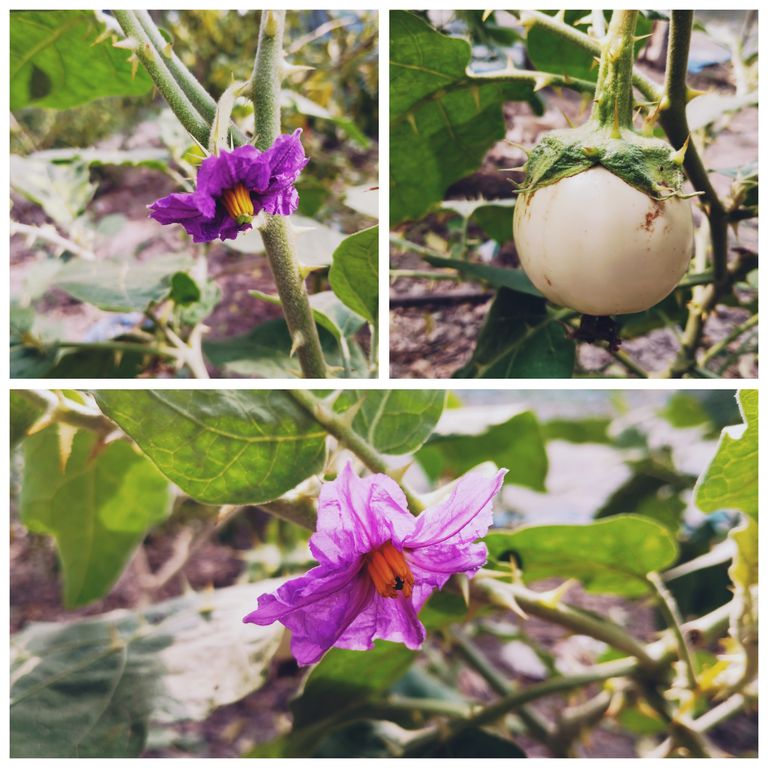
Profitable Production of White Eggplant.
White eggplant, also known as white brinjal, is gaining popularity among farmers and consumers due to its unique appearance, taste, and numerous health benefits. This variety of eggplant stands out for its creamy white color and smooth texture, offering a delightful alternative to the traditional purple eggplant. Cultivating white eggplant can be a profitable venture when managed efficiently. This blog will guide you through the essential steps and strategies to achieve success in white eggplant farming.
Why Choose White Eggplant for Cultivation?
- High Market Demand: White eggplant is a niche product that attracts premium prices in local and international markets. Its unique look and flavor appeal to health-conscious consumers and chefs.
- Health Benefits: It is rich in antioxidants, fiber, vitamins, and minerals, making it a preferred choice for healthy diets.
- Adaptability: White eggplant can thrive in diverse climatic conditions, making it suitable for various regions.
Selecting the Right Variety
There are several white eggplant varieties, including:
White Beauty: Known for its smooth skin and mild flavor.
Ghostbuster: A hybrid variety offering high yields.
Casper: A slender and creamy-skinned variety.
Choose a variety based on local market preferences, climate, and soil conditions.
Soil Preparation and Planting
- Soil Requirements: White eggplant thrives in well-drained, loamy soil with a pH between 5.5 and 6.8. Conduct soil testing to ensure optimal conditions.
- Land Preparation: Plow the field to loosen the soil and remove weeds. Enrich the soil with organic manure or compost for better fertility.
- Seedling Preparation: Sow seeds in a nursery and transplant seedlings after 4-6 weeks when they are 4-5 inches tall. Maintain a spacing of 2-3 feet between plants for proper growth.
Fertilization and Irrigation
- Nutrient Management: Apply nitrogen, phosphorus, and potassium fertilizers in balanced proportions. Use organic fertilizers like vermicompost to enhance soil fertility.
- Irrigation: Water the plants regularly, especially during flowering and fruiting stages. Avoid waterlogging, as it can damage roots.
Pest and Disease Management
White eggplants are susceptible to pests like aphids, whiteflies, and fruit borers, and diseases such as wilt and blight.
- Preventive Measures:
Use disease-resistant seeds.
Rotate crops to reduce pest buildup.
Employ mulching to retain soil moisture and prevent weed growth.
- Natural Control: Use neem oil or bio-pesticides to control pests.
- Chemical Control: Apply pesticides judiciously to avoid harmful residues.
Harvesting and Post-Harvest Management
- Harvesting: White eggplants are ready for harvest 60-90 days after transplantation. Pick them when they are firm, glossy, and of the desired size.
- Post-Harvest Care:
Sort and grade the eggplants based on size and quality.
Pack them in ventilated crates to prevent bruising.
Store in a cool, dry place to extend shelf life.
Marketing and Profitability
- Market Channels: Explore local markets, supermarkets, and online platforms for selling your produce. Export opportunities can further enhance profitability.
- Value Addition: Consider processing white eggplants into pickles, sauces, or frozen products to fetch higher returns.
- Profit Analysis: With proper planning, white eggplant farming can yield a profit margin of 40-60% due to its high demand and premium pricing.
Tips for Success
Stay Updated: Keep up with market trends and consumer preferences.
Adopt Technology: Use modern farming techniques like drip irrigation and greenhouse farming for better yields.
Sustainable Practices: Focus on organic farming to cater to health-conscious consumers.
White eggplant farming is an exciting and profitable venture for farmers willing to adopt modern techniques and market strategies. With proper planning, efficient pest management, and a focus on quality, you can turn this unique crop into a lucrative business. Start small, expand gradually, and reap the benefits of cultivating this remarkable vegetable.
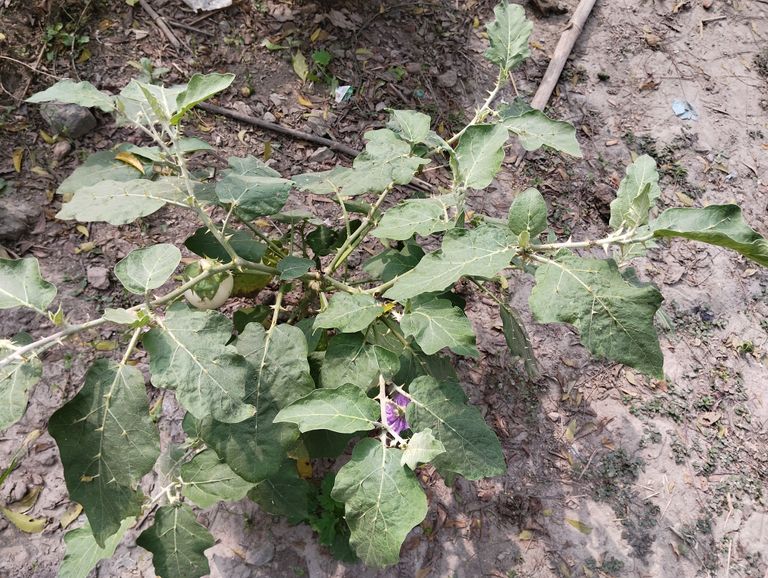
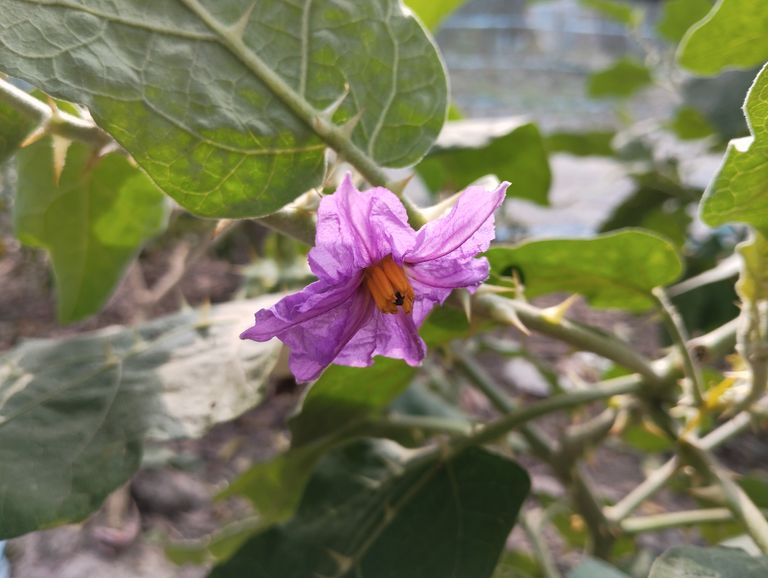
Health Benefits of Eating White Eggplant
White eggplant, a unique and less common variety of eggplant, is gaining popularity due to its distinct taste, texture, and impressive nutritional profile. Consumed across various cuisines, this vegetable offers numerous health benefits. In this blog, we’ll explore the nutritional composition and the various ways white eggplant can enhance your health.
Nutritional Value of White Eggplant
White eggplant is rich in essential nutrients while being low in calories. Here's what makes it a powerhouse of health:
Low Calories: Perfect for weight-conscious individuals, as it contains minimal calories and almost no fat.
Rich in Dietary Fiber: Promotes healthy digestion and helps in maintaining cholesterol levels.
Vitamin C and Vitamin B Complex: Boosts immunity and supports energy metabolism.
Antioxidants: Contains nasunin, an antioxidant that protects brain cells and prevents oxidative stress.
Potassium and Magnesium: Helps in maintaining heart health and regulating blood pressure.
Health Benefits of White Eggplant
- Supports Heart Health
White eggplant is packed with potassium, which helps regulate blood pressure. The antioxidants in the vegetable also combat inflammation, reducing the risk of heart diseases. Additionally, the fiber content helps control cholesterol levels, contributing to overall cardiovascular health.
- Aids in Weight Management
Being low in calories and rich in fiber, white eggplant is an ideal addition to weight-loss diets. The fiber helps keep you fuller for longer, reducing unnecessary calorie intake.
- Improves Digestion
The high fiber content in white eggplant supports healthy digestion by preventing constipation and promoting regular bowel movements. It also helps maintain a healthy gut microbiome.
- Enhances Brain Health
The presence of nasunin, a potent antioxidant in white eggplant, protects brain cells from damage caused by free radicals. Regular consumption can help improve cognitive function and prevent neurodegenerative diseases.
- Manages Blood Sugar Levels
White eggplant has a low glycemic index and high fiber content, which helps stabilize blood sugar levels. It’s particularly beneficial for people with diabetes, as it slows down the absorption of sugar into the bloodstream.
- Boosts Immunity
White eggplant is rich in vitamin C, a nutrient essential for strengthening the immune system. It helps the body fight off infections and promotes quicker recovery.
- Prevents Cancer
The antioxidants and phytonutrients in white eggplant help neutralize free radicals, reducing the risk of cancer. They protect the cells from oxidative damage, which is a leading cause of cancer development.
- Promotes Skin Health
Vitamin C and other antioxidants in white eggplant play a role in improving skin health. They combat skin aging, reduce wrinkles, and promote a glowing complexion.
- Supports Bone Health
White eggplant contains essential minerals like calcium, magnesium, and phosphorus, which are crucial for maintaining strong bones and preventing osteoporosis.
- Detoxifies the Body
The fiber and antioxidants in white eggplant aid in flushing out toxins from the body, improving overall health and vitality.
How to Include White Eggplant in Your Diet
White eggplant is versatile and can be cooked in various ways:
Roasted or Grilled: Enhances its natural flavor and makes a delicious side dish.
Curries and Stews: Absorbs flavors well, making it an excellent ingredient in spicy dishes.
Stuffed Eggplant: A wholesome dish when stuffed with vegetables, herbs, or cheese.
Eggplant Fries: A healthier alternative to potato fries, baked or air-fried with minimal oil.
Mashed or Pureed: Used in dips like baba ganoush or spreads for sandwiches.
Precautions While Consuming White Eggplant
People with allergies to nightshade vegetables like tomatoes or potatoes should consume white eggplant cautiously.
Pregnant and lactating women should consult a doctor before including large amounts in their diet due to its potential alkaloid content.
White eggplant is not just a culinary delight but also a treasure trove of health benefits. Whether you’re looking to improve digestion, support weight loss, or boost your immunity, this humble vegetable can be a great addition to your diet. Explore its versatility in the kitchen and enjoy its numerous health benefits.
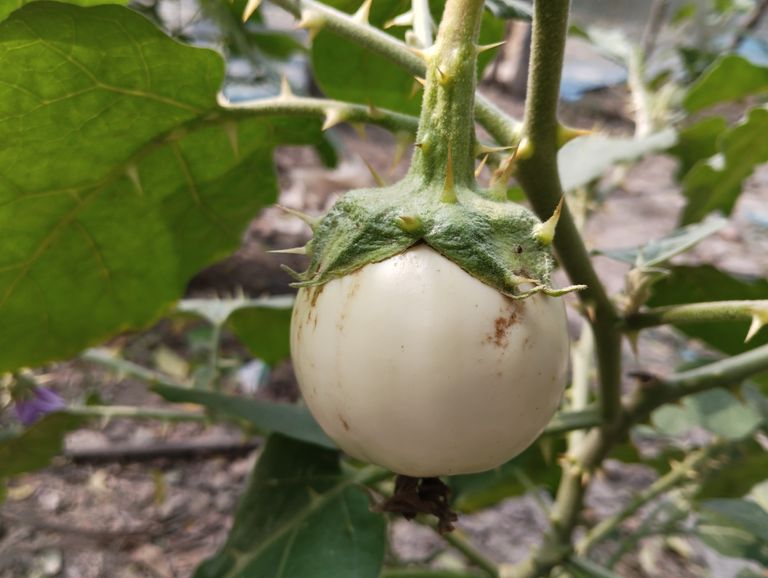
White Eggplant Mash (Sada Beguner Bharta) Recipe and Blog
White eggplant, or "sada begun," is a rare yet delicious variety of eggplant that holds a special place in Bengali cuisine. Known for its creamy texture and subtle flavor, it’s an excellent base for creating a simple yet delectable mashed dish called Bharta. Today, we will explore the art of making Sada Beguner Bharta, a comfort food that pairs perfectly with plain steamed rice.
Why White Eggplant?
White eggplants are less bitter and more tender than their purple counterparts. They have a unique creamy consistency when roasted, making them ideal for dishes like bharta. This recipe relies on the natural flavor of the eggplant, enhanced with a few simple ingredients.
Ingredients
To make this flavorful dish, you’ll need:
White eggplants (sada begun) - 2 medium-sized
Onion - 1 small, finely chopped
Garlic - 3-4 cloves, minced
Green chilies - 2-3 (adjust to taste)
Mustard oil - 1 tablespoon
Salt - to taste
Coriander leaves - a handful, finely chopped (optional)
Instructions
Step 1: Roast the Eggplants
- Wash the white eggplants thoroughly and pat them dry.
- Place the eggplants directly on a flame or in an oven set to 400°F (200°C).
- Roast them until the skin is charred and the flesh inside turns soft (approximately 10-15 minutes). Turn them occasionally for even roasting.
- Once roasted, let them cool slightly before peeling off the charred skin.
Step 2: Prepare the Mash
- In a mixing bowl, mash the roasted eggplants until smooth. You can leave it slightly chunky if you prefer texture.
- Add minced garlic, chopped onion, green chilies, mustard oil, and salt. Mix well to combine.
Step 3: Garnish and Serve
- Optionally, sprinkle chopped coriander leaves for added freshness.
- Serve the Sada Beguner Bharta with steamed rice and a drizzle of extra mustard oil if desired.
Tips for Perfect Bharta
- Mustard Oil: The smoky flavor of mustard oil is key to authentic bharta. If unavailable, substitute with olive oil, but the taste will differ.
- Fire-Roasting vs. Oven Roasting: Roasting over an open flame gives the eggplant a smoky flavor. If using an oven, you can achieve a similar effect by broiling the eggplants.
- Add-Ons: For variation, add crushed peanuts or a dash of lime juice for a tangy twist.
Cultural Significance
Bharta is more than just a dish in Bengali households; it’s a reflection of simplicity and warmth. Whether it's purple eggplants or the more delicate white variety, bharta brings people together. The use of mustard oil, chilies, and raw onions creates a harmony of flavors that appeals to the Bengali palate.
Health Benefits
White eggplants are low in calories and high in fiber, making them a healthy choice. They are also a good source of vitamins and antioxidants, promoting better digestion and overall health. Pairing it with rice creates a balanced, wholesome meal.
Final Thoughts
Sada Beguner Bharta is a humble yet irresistible dish that beautifully showcases the versatility of white eggplants. Whether you’re cooking for a family dinner or exploring Bengali cuisine for the first time, this dish is a must-try. Simple ingredients, minimal effort, and maximum flavor – that’s the magic of bharta.
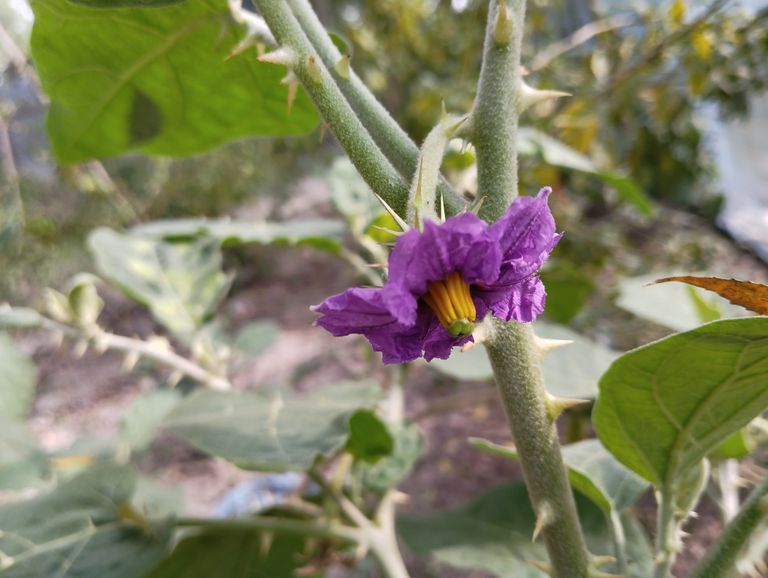
Planting Distance for White Eggplants: A Comprehensive Guide
White eggplants are a unique and elegant addition to any garden, offering both aesthetic appeal and delicious produce. For gardeners aiming to cultivate this variety, understanding the correct planting distance is crucial for healthy growth and optimal yield. This blog will guide you through the best practices for planting white eggplants, ensuring your garden thrives.
Importance of Proper Spacing
Plant spacing plays a vital role in the overall health and productivity of your eggplants. Here’s why it matters:
- Adequate Air Circulation: Proper spacing prevents overcrowding, reducing the risk of fungal diseases like powdery mildew.
- Optimal Sunlight Exposure: Each plant gets equal access to sunlight, promoting healthy photosynthesis.
- Nutrient Distribution: Adequate spacing ensures that each plant receives enough soil nutrients without competing with others.
- Ease of Maintenance: Well-spaced plants are easier to water, fertilize, and harvest.
Recommended Planting Distance for White Eggplants
- Between Plants: Maintain a distance of 18 to 24 inches (45 to 60 cm) between individual plants. This allows sufficient space for their branches to spread.
- Between Rows: Keep rows 24 to 36 inches (60 to 90 cm) apart. This spacing accommodates plant growth and makes it easier to move around for care and harvesting.
- In Containers: For container gardening, choose pots that are at least 12 inches in diameter for each plant. Ensure the pots are spaced apart to allow airflow.
Preparing the Soil
White eggplants thrive in well-draining, nutrient-rich soil. Before planting, consider these tips:
Soil pH: Maintain a pH level between 6.0 and 6.5. Test your soil and adjust accordingly using lime or sulfur.
Fertilization: Enrich the soil with compost or organic matter. Use a balanced fertilizer with nitrogen, phosphorus, and potassium for better growth.
Tilling: Loosen the soil to a depth of 12 inches to encourage root penetration.
Planting Process
- Seedlings or Seeds: You can grow white eggplants from seeds or transplant seedlings. Start seeds indoors 6-8 weeks before the last frost date.
- Transplanting: Once the seedlings are 6-8 inches tall and all frost risk has passed, transplant them outdoors.
- Planting Depth: Dig holes deep enough to cover the root ball, ensuring the plants stand upright.
Mulching and Watering
Mulching: Apply a 2-3 inch layer of organic mulch around the base of each plant. Mulch helps retain soil moisture, suppress weeds, and regulate soil temperature.
Watering: White eggplants require consistent watering, especially during the fruiting stage. Water deeply once or twice a week, depending on weather conditions.
Supporting the Plants
As the plants grow, they may require staking or caging to support the branches and prevent the fruits from touching the ground. Use soft ties to avoid damaging the stems.
Common Pests and Diseases
While white eggplants are relatively hardy, they can be affected by pests like aphids, flea beetles, and spider mites. Regularly inspect your plants and use natural remedies or insecticidal soaps if necessary.
Proper spacing is the foundation of a successful white eggplant harvest. By following the recommended guidelines and providing your plants with the care they need, you’ll enjoy a bountiful yield of these unique and flavorful vegetables. Whether you're a beginner or an experienced gardener, planting white eggplants can be a rewarding experience.

Diseases and Pests of White Eggplant: A Comprehensive Guide
White eggplant (Solanum melongena) is a unique variety of eggplant appreciated for its creamy-white skin, mild flavor, and ornamental value. While it is a rewarding crop, it is also susceptible to various diseases and pests that can impact yield and plant health. This blog explores the common diseases and pests of white eggplant and offers practical management strategies.
Common Diseases of White Eggplant
- Bacterial Wilt (Ralstonia solanacearum)
Symptoms: Sudden wilting of leaves without yellowing, browning of vascular tissues in stems, and plant death in severe cases.
Causes: Bacterial infection often spread through soil, water, and contaminated tools.
Management:
Rotate crops with non-solanaceous plants.
Use disease-resistant varieties.
Ensure proper drainage to avoid waterlogging.
- Fusarium Wilt (Fusarium oxysporum f. sp. melongenae)
Symptoms: Yellowing and wilting of leaves, browning of stem vascular tissues, and stunted plant growth.
Causes: Fungal infection that thrives in warm, moist soil.
Management:
Apply soil solarization before planting.
Use resistant varieties and sterilized soil.
Avoid overwatering.
- Powdery Mildew (Leveillula taurica)
Symptoms: White, powdery patches on leaves, stems, and flowers. Leaves may curl and dry out.
Causes: Fungal infection favored by high humidity and poor air circulation.
Management:
Prune overcrowded plants for better airflow.
Apply sulfur-based fungicides or neem oil.
- Anthracnose (Colletotrichum spp.)
Symptoms: Sunken, dark lesions on fruits and leaves, which may lead to fruit rot.
Causes: Fungus spread by water splashes and infected plant debris.
Management:
Remove and destroy infected plants.
Use copper-based fungicides as preventive measures.
Common Pests of White Eggplant
- Aphids (Aphis gossypii)
Symptoms: Yellowing and curling of leaves, sticky honeydew secretion, and stunted growth.
Management:
Introduce natural predators like ladybugs.
Spray plants with insecticidal soap or neem oil.
- Whiteflies (Bemisia tabaci)
Symptoms: White, tiny insects on the underside of leaves, yellowing of leaves, and reduced plant vigor.
Management:
Use sticky traps to catch whiteflies.
Apply horticultural oils to control infestations.
- Spider Mites (Tetranychus urticae)
Symptoms: Yellow or bronze speckling on leaves, webbing on plants, and leaf drop.
Management:
Spray water on plants to dislodge mites.
Use miticides or neem oil for severe infestations.
- Eggplant Fruit and Shoot Borer (Leucinodes orbonalis)
Symptoms: Larvae bore into shoots and fruits, causing wilting, fruit distortion, and reduced yield.
Management:
Remove and destroy infested plant parts.
Apply biological controls like Bacillus thuringiensis.
Preventive Measures for Healthy White Eggplant
Soil Preparation: Ensure well-drained, fertile soil with adequate organic matter.
Crop Rotation: Rotate crops regularly to reduce disease buildup.
Sanitation: Remove weeds and plant debris that may harbor pests and diseases.
Proper Spacing: Plant eggplants with enough space to promote air circulation.
Integrated Pest Management (IPM): Use a combination of cultural, biological, and chemical methods for pest and disease control.
White eggplant, while prone to several diseases and pests, can thrive with proper care and management. By identifying problems early and adopting preventive and curative measures, gardeners and farmers can enjoy a healthy and productive crop. With vigilance and sustainable practices, growing white eggplants can be a rewarding experience.